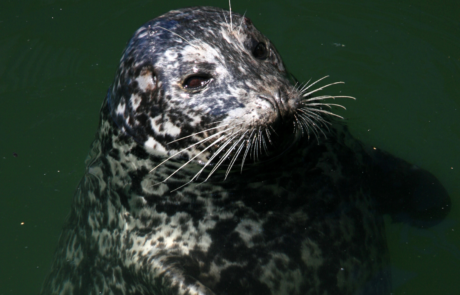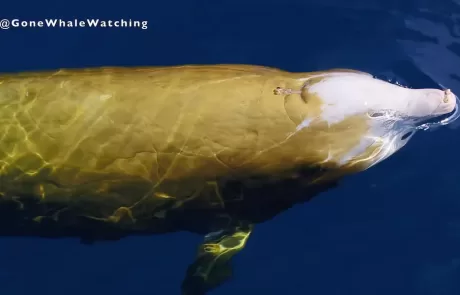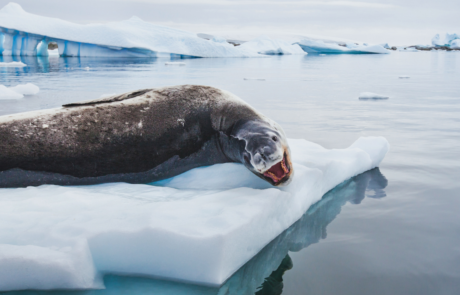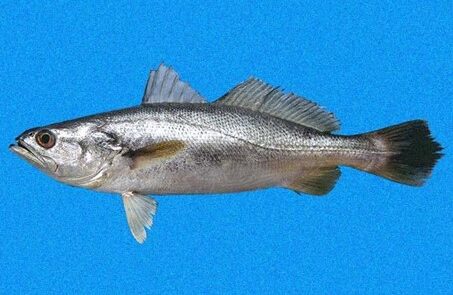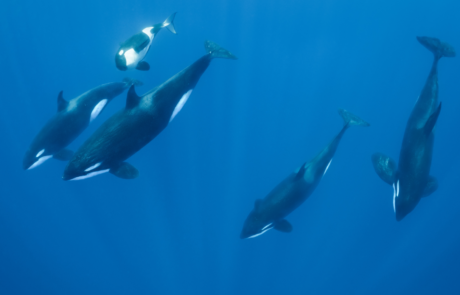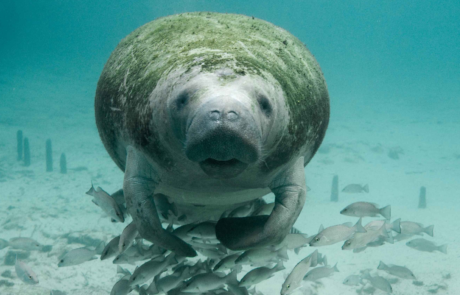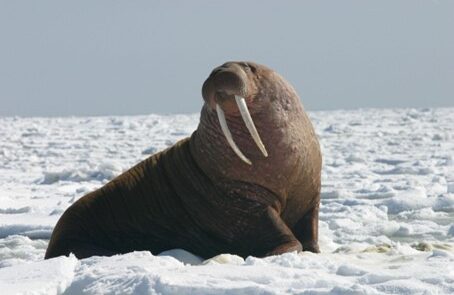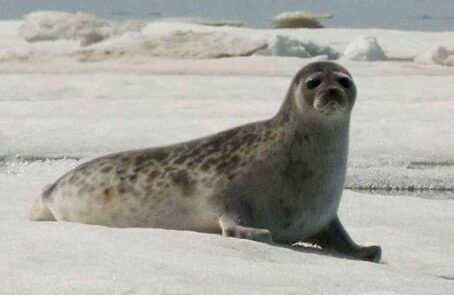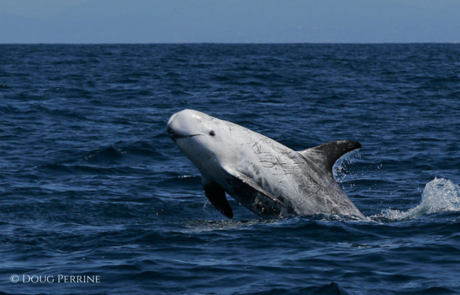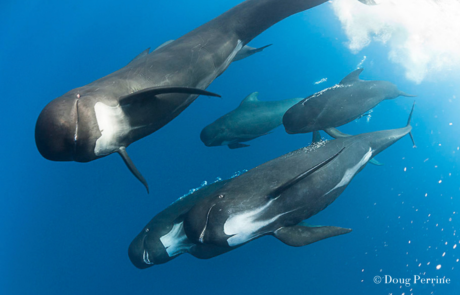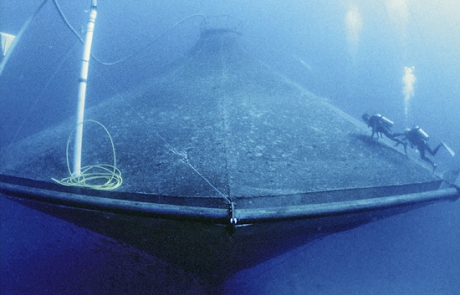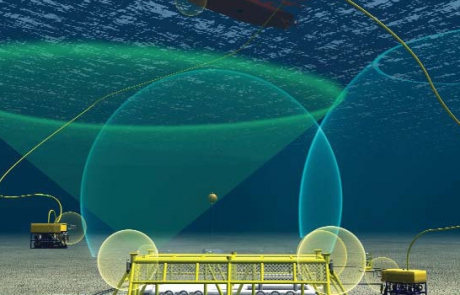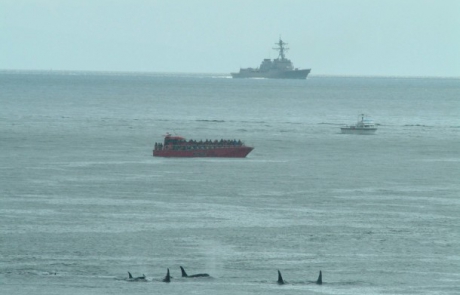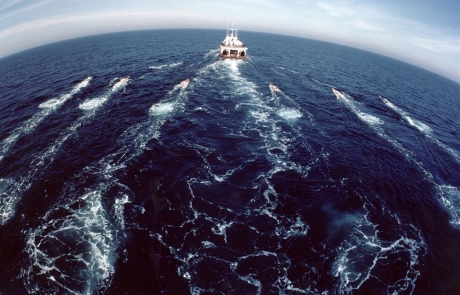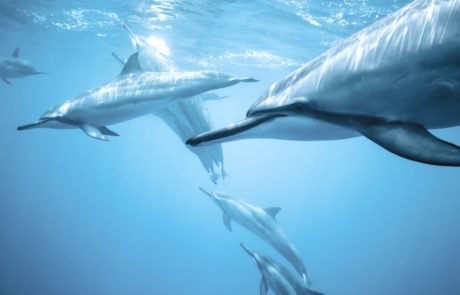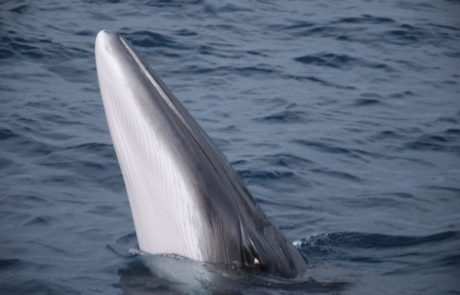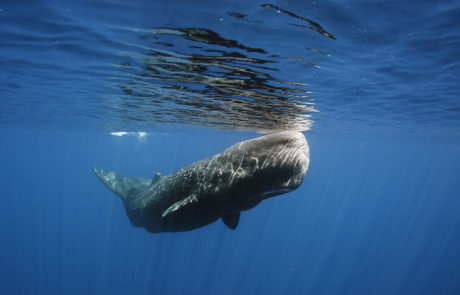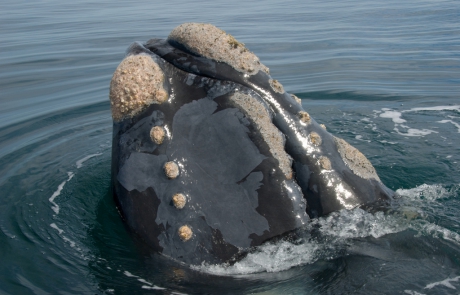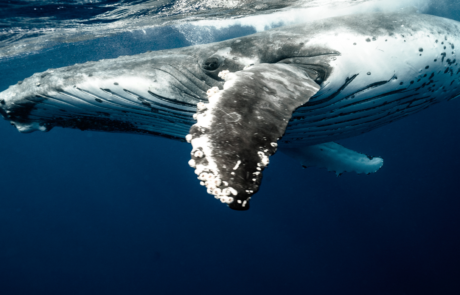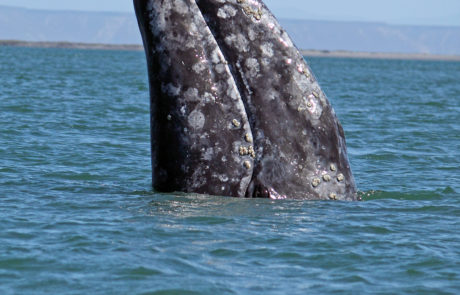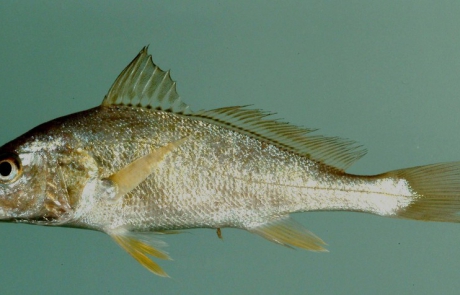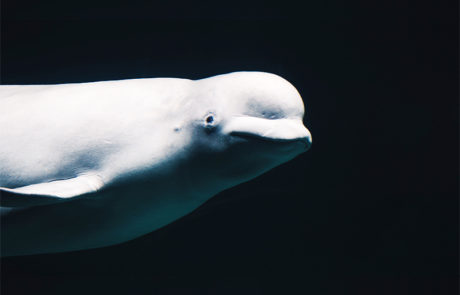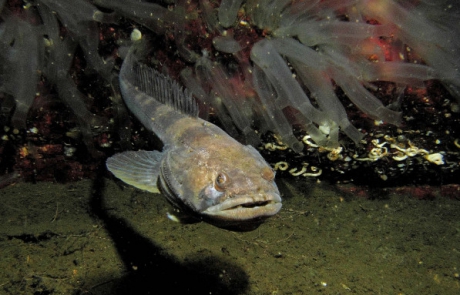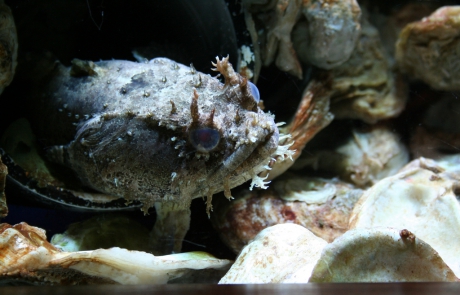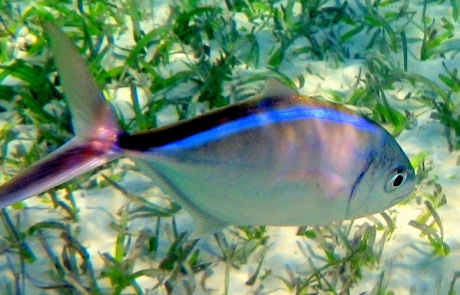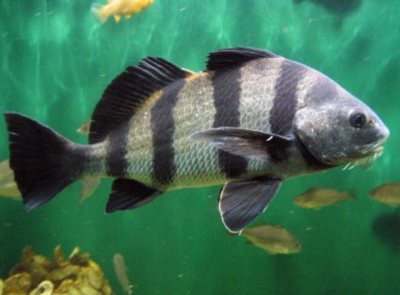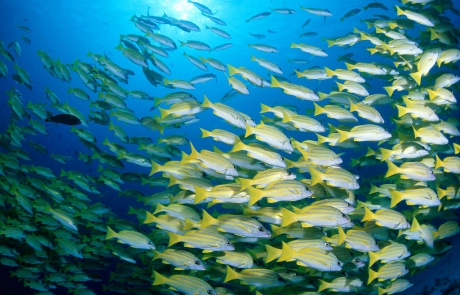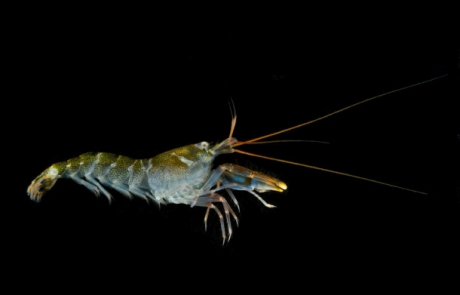Sounds of the Harbor Seal Harbor seals are recognized for emitting a diverse range of sounds, both beneath the water's surface and in the air. Their underwater vocalization is characterized as a roar. They can detect underwater tonal signals between 0.25 and 100 kHz. In addition, they generate brief barks, tonal honks, grunts, [...]
Cuvier’s Beaked Whale
Jason Roberts2023-12-05T02:39:31+00:00Cuvier's Beaked Whale Sounds The Cuvier's beaked whale holds the record for the deepest plunge by a marine mammal. The deepest & longest recorded dive of a Cuvier's beaked whale is 9,816 feet (2,992 m) and 222 minutes, descending roughly the length of eight Empire State Buildings. Like other toothed whales, Cuvier's beaked [...]
Leopard Seal
Jason Roberts2023-12-05T02:42:53+00:00Leopard Seal Sounds Leopard seals are quite the vocalists of the underwater world, especially during the austral summer. The males produce loud calls, for many hours each day. Their vocalizations can be categorized into two types: vocalizing, when they are making noises underwater, and silencing, which is the breathing period at the air [...]
Scalyfin Corvina
Jason Roberts2023-08-08T22:00:52+00:00Scalyfin Corvina Photo by Robinson R. LATIN NAME Cynoscion squamipinnis LENGTH 65 cm max. (25.5in) WEIGHT 3 kg max. (~6lbs) LIFETIME 2 to 3 years PHYSICAL TRAITS Color is generally silvery or greyish on the upper back. The tip of the lower jaw is dusky and the inside of the mouth [...]
Orca or “Killer Whale”
Jason Roberts2023-12-05T02:44:52+00:00Orca or "Killer Whale" Sounds Orcas are community animals, living in matrilineal pods - each with their distinct cultures and dialects. They hunt collaboratively, using social signals (squeaks, whistles, and chirps) as well as bursts of high-frequency bio-sonar, which we hear as buzzes and clicks. Bio-sonar are bursts of high-frequency energy which they [...]
Manatee
Jason Roberts2023-12-05T02:40:01+00:00Sounds of the Manatee Manatees, also known as sea cows, have a unique vocalization system. They use a variety of sounds or vocalizations to communicate with each other, especially between mothers and calves. These sounds range from squeaks and chirps to more complex sequences, and are used for various purposes such as maintaining [...]
Walrus
Jason Roberts2023-08-08T21:43:28+00:00Walrus Photo by Joe Garlich-Miller LATIN NAME Odobenus rosmarus LENGTH Males: 2.7m to 3.6m (9 ft - 12 ft) Females: 2.3m - 3.1m (7.5 ft - 10 ft) WEIGHT Males: 800kg - 1,700kg (1,764 lb - 3,748 lb) Females: 400kg - 1,250kg (882 lb - 2,756 lb) LIFETIME Approximately 40 years [...]
Ringed Seal
Jason Roberts2023-08-08T21:40:54+00:00Ringed Seal Photo by NOAA Seal Survey LATIN NAME Pusa hispida LENGTH Average 1.5m (5 ft). Depending on the subspecies can be 100 cm to 175 cm (39.5 in to 69 in) WEIGHT 50 kg –70 kg (110 lb – 150 lb) LIFETIME 15 to 20 years PHYSICAL TRAITS This species [...]
Risso’s Dolphin
Jason Roberts2023-12-04T21:12:49+00:00Risso's Dolphin Vocalizations Risso's dolphins unusual (and beautiful) looking cetaceans also have a variety of unusual features in their acoustic repertoire. They produce burst-pulses (buzzes) and combine them with highly synchronized whistles. Their characteristic sounds place them closer to orcas than any other dolphin species! Listen to their vocalizations in the audiograph below. [...]
Pilot whale
Jason Roberts2023-12-12T20:18:03+00:00Pilot Whale Sounds Pilot whales are the second largest member of the dolphin family, after orcas. Their communication is a rich tapestry of sounds, each serving a unique purpose in their daily lives. Echolocation clicks act as their guiding light in the deep, aiding them in their search for food. Whistles and burst [...]
How Fish Hear
Michael Stocker2017-02-08T16:40:49+00:00How Fish Hear Not all fish have the same morphology. Fish can have as many as 3 systems for hearing. The lateral line is a line of nerves (neuromasts) that extend out of the side of the body of a fish. These nerves sense “particle motion” or the physical movement of the water. The swim [...]
Brief Intro to the Hearing Systems of Fish
Michael Stocker2017-02-08T16:40:49+00:00Brief into to the Hearing Systems of Fish You can determine a lot about a fish’s hearing from their environment. Fish in turbid, dark environments can have very developed hearing systems. Fish that are more sedentary and rely on disguise may have only rudimentary hearing systems because they don’t need to hear. (Instead their sense [...]
Intro to Odontocetes & Mysticetes
Michael Stocker2017-02-08T16:40:49+00:00Odontocetes & Mysticetes Cetaceans are animals that were amphibious who came back into the water. There are two families of whales the Mysticetes (mustache whales) and the Odontocetes, the toothed whales. Main Points: There are 2 “sub-orders” of cetaceans: odontocetes and mysticetes. Odontocetes: There are two families of odontocetes distinguished by the shape of [...]
Skull Morphology
Michael Stocker2017-02-08T16:40:49+00:00Skull Morphology All vertebrates have a middle ear and inner ear systems in an auditory bulla or otic capsule that is variously fused, embedded, or attached to their skulls. The morphology, or variations in how these attachments evolved tells us much about the particular animal’s adaptations to their environment. While we are still learning about [...]
How Hearing Works
Michael Stocker2017-02-08T16:40:49+00:00How Hearing Works Hearing has evolved in animals based on the acoustical information they need to determine their dynamic relationships with their surroundings. Hearing adaptations reflect predator/prey relationships, community settings, and the strength or suitability of other perceptions. For example: you are likely to find more complex hearing adaptations in habitats that are less conducive [...]
Acoustic Harassment Devices
Michael Stocker2023-05-17T04:05:44+00:00Acoustic Harassment Devices ACOUSTIC HARASSMENT DEVICES Marine aquaculture is a rapidly developing field. The protein conversion inefficiencies notwithstanding, the sea-pens and enclosures are also targets for marine life – mostly seals and sea lions, that don’t miss the fact that if they can broach the barriers they could [...]
Offshore Energy: Wind and Tidal Swings
Michael Stocker2025-04-09T16:26:43+00:00Links Back to Sound Library
Underwater Communication Signals
Michael Stocker2023-05-17T04:08:08+00:00Underwater Communication Signals UNDERWATER COMMUNICATION SIGNALS The ocean is largely opaque to radio frequency energy so underwater communication either needs to be transmitted by wire, or by sound. Increasingly as military and industrial processes take place in the ocean they will use various acoustical communication signals. Some of [...]
Mid-Frequency Sonar
Michael Stocker2019-04-20T21:27:43+00:00Military Sonar MILITARY SONAR Mid-Frequency military sonar has proven one of the most troubling acoustical assaults on marine life, particularly associated with catastrophic strandings of marine mammals. The most common victims have been odontocetes – toothed whales and dolphins, but Minke whales have also washed up on [...]
Low-Frequency Sonar
Michael Stocker2021-05-25T21:33:59+00:00Low-Frequency Sonar LOW-FREQUENCY SONAR came out of the work of the brilliant physical oceanographer Walter Munk. He had been working on the transmission of ‘phase coherent’ long wavelength signals since 1978. Taking advantage of the efficiency with which water transmits acoustical energy, and the far reach of low frequency, [...]
Seafloor fossil fuel processing
Michael Stocker2019-04-20T21:59:06+00:00Sea Floor Processing SEA FLOOR PROCESSING As fossil fuel exploration and production moves into ever deeper waters, developing technologies are moving much of the processing down to the sea floor. Hydrocarbon deposits are not simple pools of oil or pockets of gas; rather they are typically an untidy [...]
Seismic Airgun Surveys
Michael Stocker2019-04-23T05:54:29+00:00Seismic Airguns SEISMIC AIRGUNS Since the end of “easy oil” the fossil fuel industries are driven ever deeper into offshore oil and gas deposits. The industry as a whole contributes a substantial amount of noise to the sea. Seismic airgun surveys are second only to shipping noise in [...]
Shipping Noise
Michael Stocker2019-04-22T16:26:47+00:00Shipping Noise SHIPPING NOISE is one of the most ubiquitous sounds in the sea, generated by trans-ocean shipping. Cavitation and turbulence generated by propellers is the dominant noise source, but also transmission of mechanical noise through a ship’s hull. Some great work is being done by Chris Clark’s lab [...]
Weddell Seal
Michael Stocker2019-04-18T19:45:14+00:00Weddel Seal Weddel Seal: Photo by robnunn on Flickr. LATIN NAME Leptonychotes weddellii LENGTH 2.5-3.5 m (8.2-11.5 ft) long WEIGHT 500 kg (1100 lbs) or less LIFETIME About 20 years PHYSICAL TRAITS Their coat is mottled with large darker and lighter patches, upturned 'smiling' mouths BEHAVIOR Deep dives, which may reach [...]
Bearded Seal
Michael Stocker2019-04-22T17:47:16+00:00Bearded Seal Bearded Seal: Photo by kerryinlondon on Flickr. LATIN NAME Erignathus barbatus: Erignathus barbatus barbatus, Erignathus barbatus nautica (AKA: Square flipper seal) LENGTH 2.1 m (6.9 ft) to 2.7 m (8.9 ft) WEIGHT 200 kg (441 lb) to 430 kg (948 lb) LIFETIME Females reach sexual maturity at 3-8 years, [...]
Dolphin
Michael Stocker2019-04-22T18:07:47+00:00DOLPHINS Dolphins: Photo by lowjumpingfrog on Flickr. LATIN NAME Families Delphinidae, Platanistoidea, Odontoceti LENGTH Among the smallest of this family the Hectors, Chilean can be 4’-5’ (1.2 to 1.5 m) and and the largest, the Orcas, can be 27’ – 33’ (8 – 10m). WEIGHT Among the smallest Hector’s and Black dolphin [...]
Minke Whale
Michael Stocker2019-04-23T05:53:14+00:00Minke Whale LATIN NAME Balaenoptera, B. acutorostrata, B. bonaerensis LENGTH Males measure an average of 6.9 m (23 ft) and females 7.4 m (24 ft) WEIGHT 4–5 t (3.9–4.9 long tons; 4.4–5.5 short tons) LIFETIME It is estimated that minke whales become sexually mature at 8 years for [...]
Sperm Whale
Michael Stocker2019-04-22T18:29:15+00:00Sperm Whale Sperm Whale: Photo by NOAA Photo Library on Flickr. LATIN NAME Physeter macrocephalus (AKA: carpenter fish, common cachalot; “cachalot” is derived from an archaic French word for “tooth”) LENGTH Up to 20.5 metres (67 ft) WEIGHT 57,000 kilograms (56 long tons; 63 short tons) LIFETIME Over 70 years PHYSICAL [...]
Right Whale
Michael Stocker2019-04-22T18:59:11+00:00Right Whale Right Whale: Photo by manning999 on Flickr. LATIN NAME Eubalaena AKA Greenland whale, the black whale, the great whale, the true whale; For E. australis: antarctica (Lesson, 1828), antipodarum (Gray, 1843), temminckii (Gray, 1864); For E. glacialis: biscayensis (Eschricht, 1860), nordcaper (Lacepede, 1804); For E. japonica: sieboldii (Gray, 1864) [...]
Humpback Whale
Michael Stocker2023-12-14T22:24:30+00:00Sounds of the Humpback Whale Humpbacks primarily depend on sound for sensory perception & communication. The humpback whale song, a complex acoustic display unique to the animal kingdom, can travel thousands of miles, with its reach depending on the frequency. This song is crafted by individual males, each adding their unique touch to [...]
Gray Whale
Michael Stocker2019-04-22T19:35:19+00:00Gray Whale Gray Whale: Photo by Ryan Harvey on Flickr. LATIN NAME Eschrichtius robustus (AKA - Devil fish, mud whale) LENGTH Males 12–15m (45’–50’) Females up to 16m (52 ft WEIGHT 36 tonnes (35 long tons; 40 short tons) LIFETIME 40 - 60 years PHYSICAL TRAITS Dark slate-gray in color and covered [...]
Bowhead Whale
Michael Stocker2019-04-22T19:58:02+00:00Bowhead Whale Bowhead Whale: Photo source - Kate Stafford on Flickr. LATIN NAME Balaena mysticetus LENGTH Up to 20 m (66 ft) WEIGHT 75 tonnes (74 long tons; 83 short tons) to 100 tonnes (98 long tons; 110 short tons) LIFETIME Possibly over 200 years PHYSICAL TRAITS [...]
Atlantic Croaker
Michael Stocker2019-04-22T20:10:55+00:00Atlantic Croaker LATIN NAME Sciaenidae, Micropogonias undulatus LENGTH 12 inches (30 cm) WEIGHT 1/2 to 2 pounds (226 g to 0.9 kg)v LIFETIME 8 years PHYSICAL TRAITS Long dorsal fin that almost reaches the tail BEHAVIOR Migrate offshore to spawn, spend winter offshore on continental shelf, bottom dwellers, sounds are [...]
Belugas
Michael Stocker2019-04-22T20:24:42+00:00Beluga Whale LATIN NAME Delphinapterus leucas AKA Sea canary, white whale LENGTH 5 m (16 ft) WEIGHT Males weigh 1,100 – 1,600 kg (2,400 and 3,500 lb), occasionally up to 1,900 kg (4,200 lb) while females weigh 700 – 1,200 kg (1,500 and 2,600 lb) LIFETIME Not sufficient evidence [...]
Barred Grunt
Michael Stocker2019-04-22T20:38:12+00:00Barred Grunt Photo by Richard Bejarano LATIN NAME Haemulidae conodon nobilis AKA Cro-cro grunt / Yellow Cro-cro LENGTH Max 33.6cm, avg 25 cm (max 12” avg 10”) WEIGHT Max 588 g (1.3 lbs.) LIFETIME 10 years PHYSICAL TRAITS Oblong, compressed, perch-like fishes. Grunts possess prominent pharyngeal teeth. Stridulation of the [...]
Midshipman
Michael Stocker2019-04-22T20:56:04+00:00Midshipman Midshipman: Photo by roncasual on Flickr. LATIN NAME Porichthys notatus AKA Plainfin midshipman, Humming Toadfish, California Canary fish LENGTH Typical length 15 cm (6”) Max length: 38.0 cm(15”) LIFETIME Not sufficient evidence PHYSICAL TRAITS Olive brown to bronze or dark iridescent purple on dorsal surface, paler on sides with a [...]
Oyster Toadfish
Michael Stocker2019-04-22T21:17:33+00:00Oyster Toadfish Oyster Toadfish: Photo by Flying Cat Studios on Flickr. LATIN NAME Opsanus tau AKA Ugly toad, Oyster cracker, Bar dog, Dowdy LENGTH Avg. 30 cm (12”) max 38 cm (15”) WEIGHT Max 580g (1.3 lbs) LIFETIME Both males and females mature in their second year and live to approximately 8 and 5 [...]
Bar Jack
Michael Stocker2019-04-22T21:31:16+00:00Bar Jack Bar Jack: Photo by Michael McDonough on Flickr LATIN NAME Carangoides ruber AKA Bar Jack, Red Jack, Carbonero, Blue-striped Cavalla, Passing Jack LENGTH 40 – 69 cm (15” – 23”) WEIGHT 4–5 t (3.9–4.9 long tons; 4.4–5.5 short tons) LIFETIME Both males and females mature by 3-4 years. PHYSICAL [...]
Black Drum
Michael Stocker2019-04-22T21:45:14+00:00Black Drum Photo by Peter Wilson LATIN NAME Pogonias cromis AKA Texas Drum, Sea Drum, Saltwater Drum, Gray Drum, Drumfish, Striped Drum, Tambor – Juveniles under 1 lb called “Butterfly drum” Fish over 30lbs called “Bull Drum” LENGTH 390cm (16”) at 3 years, up to 1m (40”) WEIGHT Avg. 30-40 [...]
Perch
Michael Stocker2019-04-22T22:01:23+00:00Sea Perch Sea Perch: Photo by flickerphotoson Flickr. LATIN NAME Perca sp., Macquaria ambigua, Leiopotherapon unicolor LENGTH From 2 cm to 2m (Nile Perch) WEIGHT From a few grams to 200kg LIFETIME Years to decades PHYSICAL TRAITS Long rounded stature, rough scales, two dorsal fins – the first spiny and [...]
Snapping Shrimp
Michael Stocker2019-04-22T22:12:09+00:00Snapping Shrimp Snapping Shrimp: Photo by crabby_taxonomist on Flickr. LATIN NAME Alpheidae AKA Pistol shrimp, Alpheid shrimp LENGTH 3 to 5 cm WEIGHT Not sufficient information LIFETIME Not sufficient information PHYSICAL TRAITS Distinctive for its disproportionately large claw, claw can be on either arm, no pincers, instead there is [...]



